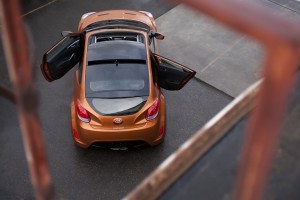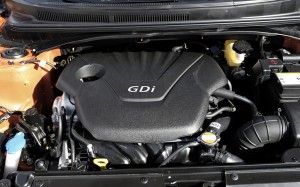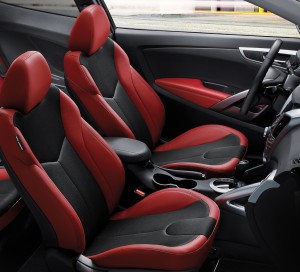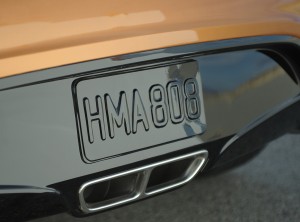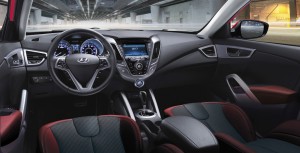
The Hyundai Veloster looks like a sports car and handles like a sports car, but it sips fuel like an econobox.
Where is it written that fuel efficiency has to mean boring? Why does saving money at the gas station mean conforming to normal? Why can’t a fuel sipper also be fun to drive?
Hyundai’s product planners must have asked themselves those questions. And they decided to say “no” to convention.
How else to explain this little bit of weirdness that Hyundai calls the Veloster? Even the name is a weird. The guys at the local Salvation Army looked at the back – with its very noticeable Veloster nameplate – and still asked what it was. Velociter? Velociraptor? And it has three doors. Not two doors and a hatch, but three actual doors. More on that later.
The name is a bit of a misnomer. The first part of the name comes from the Italian word “veloce,” which means rapid. While the car may look fast, it isn’t.
Powered by a 138-horsepower four cylinder pushing as much as 2,813 pounds, the Veloster won’t win many stoplight grand prix. But it is likely to annihilate most cars when performance at the pump is taken into account. City mileage ranges from 28-29 and highway is 38-40, depending on transmission.
But that’s OK. While the Veloster would certainly be more fun with some more power (A 208-horsepower turbo is expected in late 2012), it also would have to give up its status as the coolest-looking high-mileage car sold in this country.
The folks in Hyundai’s design studios must be thoroughly enjoying their jobs of late. Look at the vehicles they’ve designed recently. The Sonata finally has the looks to match its musical name. The new Elantra leaves its forgettable predecessors in the dust.
But the Veloster takes style to new level. The front end has more scoops and wild angles than a jet fighter. The profile says hatchback, but the roof is lower and the tail is higher than most hatches.
Hyundai resisted the norm that would have said the Veloster would wear skinny tires designed to maximize fuel efficiency. Seventeen-inch 215/50 tires (215/45s on 18s are optional), give the Veloster a sporty look and backs it up with good grip in the turns.
The interior is typical modern Hyundai, which is to say competitive with the best of the current crop of cool-looking small cars with fun interiors. All of the controls work well, there’s plenty of space for travel junk and the seats are comfortable and supportive.
But the interior shows that there are drawbacks related to the unusual shape. Headroom is lacking – at 5-foot-10 with a long torso and stubs for legs, the top of my ballcap brushed the roof, especially if the sunroof cover was closed. And the sun visor was uncomfortably close to my head.
Of course any car with an odd number of doors is a little weird. Hyundai wanted the sleek look of a two-door, but it also wanted the practicality of rear doors. So it compromised and gave it one rear door on the passenger side.
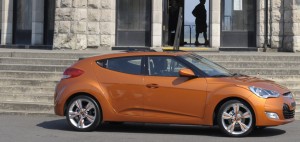
The Veloster has a small third door on the passenger side and a profile that suggests it is faster than it is.
Some people have compared the Veloster to the Saturn SC coupe, some of which had a third door. But the Saturn’s extra opening was on the driver’s side and could only open when the driver’s door was open.
Hyundai put the extra door on the passenger side because that is the safer side to enter when parallel parked. It’s the reason the first minivans had their single sliding door on the passenger side. The Veloster’s driver’s door is actually a few inches longer than the front passenger door.
The Veloster’s extra door looks extremely small, particularly at the bottom, which looks like a trip hazard for your basic size 12 loafer. Somewhat surprisingly, I was able fold myself into the opening and actually found the rear seats somewhat comfortable, so long as I slouched a little. So I tried sliding across the cupholders – Velosters are four seats only – to sit behind the driver’s seat. So long as I sat knees apart, it wouldn’t require a chiropractor visit.
As it turns out, slouching in the rear seats of a Veloster is actually a safety measure. That’s because if someone closes the hatch while you’re sitting in the back seat, you better duck. There’s even a warning sticker under the hatch.
Speaking of the hatch, the rear opening is one area where Hyundai let style override ease of use. The liftover height is high and the load floor is a long way down. The bottom of the opening is rounded and narrow, limiting its usefulness for hauling larger items.
There’s often a price to pay for style. Ask any woman if she wears four-inch heels because they’re comfortable. A taller guy who buys a Veloster will accept that his melon will brush the headliner and he’ll likely ask a buddy if he could borrow his pickup truck when there’s a bulky load to move.
So those demerits are simply part of the package.
Where Hyundai could have done better is the way the car handles. The wide tires on a relatively lightweight car cause it to follow road grooves like a bloodhound searching out a scent. This leads to constant steering connections at just about any speed above 45 mph.
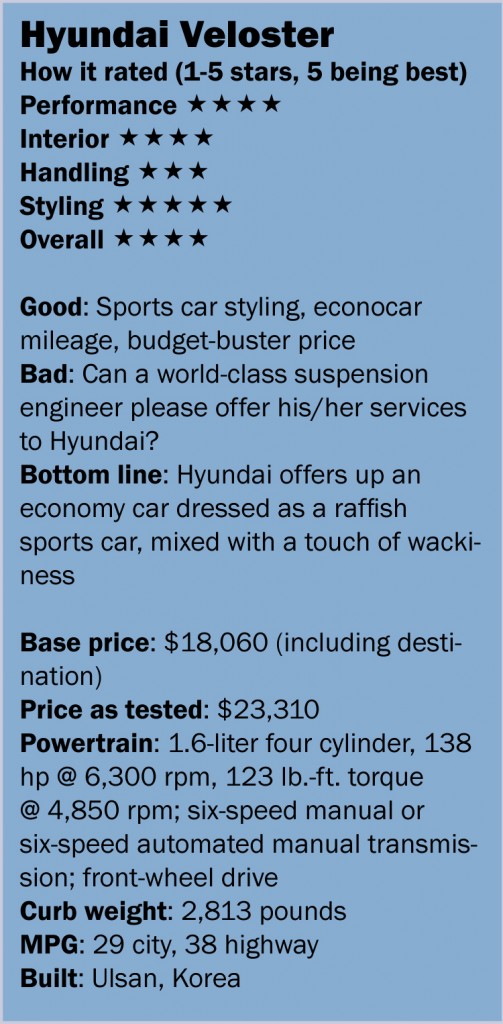 The ride is stiff, but that’s part of the deal. Remember, this is basically a sports car without the big horsepower engine. Still, it could use better control. The rear end tends to sidestep when confronted with uneven pavement. If Hyundai/Kia ever truly gets a handle on ride and handling, it could rule the automotive world.
The ride is stiff, but that’s part of the deal. Remember, this is basically a sports car without the big horsepower engine. Still, it could use better control. The rear end tends to sidestep when confronted with uneven pavement. If Hyundai/Kia ever truly gets a handle on ride and handling, it could rule the automotive world.
While the powertrain won’t strike fear in any stoplight opponent, it is smooth. The engine revs easily to its 6,500-rpm redline and makes pleasant sounds. Most interesting though is the new six-speed, dual-clutch automated manual transmission. It’s a gem and proves that the traditional torque converter automatic’s days could be numbered.
Some critics have pointed out that the Veloster can’t match the acceleration of some its state competitors, which include the Mini Cooper and Scion tC. That’s true, but those cars can’t match the Veloster’s fuel economy.
Maybe the most shocking aspect of this car is the price. While it may look and feel like a sports car – minus the horsepower – the Veloster is priced like an economy car. It starts at $18,060 (including destination) with a six-speed manual transmission. Loaded with the $1,250 dual-clutch automated manual transmission, the $2,000 Style package and the $2,000 Technology package, the Century White test car stickered at $23,310.
For that price, you get a two-panel sunroof, Bluetooth, backup camera, navigation, the 18-inch wheels with color inserts to match the paint color, eight-speaker Dimension stereo with subwoofer, alloy pedals, keyless start and backup warning sensors.
Of course the usual safety gear that has become the norm these days is standard. Traction control, stability control, six airbags, the Veloster doesn’t skimp on any of that stuff.
Hyundai has cooked up quite the oldball with the Veloster. It may be a little quirky, but it’s exactly what we’ve asked for: a car with the flash, but not the dash. A high mileager that isn’t a penalty box. A sports car even a greenie could love.

